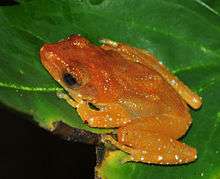Nyctixalus pictus
Nyctixalus pictus, also known as cinnamon frog, cinnamon treefrog, cinnamon bush frog, painted Indonesian treefrog, and white-spotted treefrog, etc., is a species of frog in the family Rhacophoridae.[1][2][3][4] It is found in the Malay Peninsula (including southernmost Thailand), the Philippines, and parts of the Greater Sunda Islands (northern Borneo and northern Sumatra).[1][2]
| Nyctixalus pictus | |
|---|---|
 | |
| Scientific classification | |
| Kingdom: | Animalia |
| Phylum: | Chordata |
| Class: | Amphibia |
| Order: | Anura |
| Family: | Rhacophoridae |
| Genus: | Nyctixalus |
| Species: | N. pictus |
| Binomial name | |
| Nyctixalus pictus (Peters, 1871) | |
| Synonyms[2] | |
| |
Distribution
This species is found in the Malay Peninsula (from extreme southern Thailand through Peninsular Malaysia to Singapore), Sumatra (Indonesia), Borneo (Brunei, Malaysia, and Indonesia), and the Philippines.[1][2]
Description
Nyctixalus pictus grows to about 35 mm (1.4 in) in snout–vent length;[3][4] males are slightly smaller than females. The snout is obtusely pointed. The tympanum is distinct.[5] The limbs are long and the finger and toe tips are dilated into large discs.[4][5] The fingers have no webbing whereas the toes are partly webbed.[5] Coloration is brown or reddish brown with white to yellow spots on the body.[4]
Habitat and conservation
Nyctixalus pictus occurs in the shrub and lower tree layers of primary and secondary forests at elevations below 700 m (2,300 ft)[1] (up to 1,650 m (5,410 ft) in Borneo[3]). The tadpoles develop in arboreal water-filled cavities (including phytotelms) and in rotting logs.[1][3]
Nyctixalus pictus is widespread but uncommon. Populations are threatened by habitat loss due to clearing of forests for agriculture and logging. Its range includes several protected areas.[1] In Singapore, it is only found in the Bukit Timah and Central Catchment Nature Reserves.[4]
References
- Diesmos, A.; et al. (2017). "Nyctixalus pictus (amended version of 2004 assessment)". IUCN Red List of Threatened Species. 2017: e.T58806A114112749. doi:10.2305/IUCN.UK.2017-1.RLTS.T58806A114112749.en.
- Frost, Darrel R. (2019). "Nyctixalus pictus (Peters, 1871)". Amphibian Species of the World: an Online Reference. Version 6.0. American Museum of Natural History. Retrieved 22 May 2019.
- Haas, A.; Das, I. & Hertwig, S.T. (2019). "Theloderma pictum Cinnamon Frog". Frogs of Borneo. Retrieved 22 May 2019.
- "Nyctixalus pictus (Peters, 1871)". The Digital Nature Archive of Singapore. Lee Kong Chian Natural History Museum. Retrieved 22 May 2019.
- Inger, R.F. (1966). "The systematics and zoogeography of the amphibia of Borneo". Fieldiana Zoology. 52: 1–402. doi:10.5962/bhl.title.3147.
